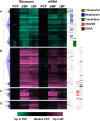Extensive stage-regulation of translation revealed by ribosome profiling of Trypanosoma brucei
- PMID: 25331479
- PMCID: PMC4210626
- DOI: 10.1186/1471-2164-15-911
Extensive stage-regulation of translation revealed by ribosome profiling of Trypanosoma brucei
Abstract
Background: Trypanosoma brucei subspecies infect humans and animals in sub-Saharan Africa. This early diverging eukaryote shows many novel features in basic biological processes, including the use of polycistronic transcription to generate all protein-coding mRNAs. Therefore we hypothesized that translational control provides a means to tune gene expression during parasite development in mammalian and fly hosts.
Results: We used ribosome profiling to examine genome-wide protein synthesis in animal-derived slender bloodstream forms and cultured procyclic (insect midgut) forms. About one-third of all CDSs showed statistically significant regulation of protein production between the two stages. Of these, more than two-thirds showed a change in translation efficiency, but few appeared to be controlled by this alone. Ribosomal proteins were translated poorly, especially in animal-derived parasites. A disproportionate number of metabolic enzymes were up-regulated at the mRNA level in procyclic forms, as were variant surface glycoproteins in bloodstream forms. Comparison with cultured bloodstream forms from another strain revealed stage-specific changes in gene expression that transcend strain and growth conditions. Genes with upstream ORFs had lower mean translation efficiency, but no evidence was found for involvement of uORFs in stage-regulation.
Conclusions: Ribosome profiling revealed that differences in the production of specific proteins in T. brucei bloodstream and procyclic forms are more extensive than predicted by analysis of mRNA abundance. While in vivo and in vitro derived bloodstream forms from different strains are more similar to one another than to procyclic forms, they showed many differences at both the mRNA and protein production level.
Figures






References
Publication types
MeSH terms
Substances
Grants and funding
LinkOut - more resources
Full Text Sources
Other Literature Sources
Molecular Biology Databases

